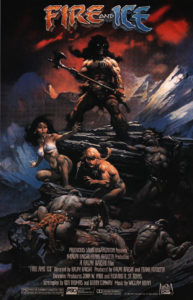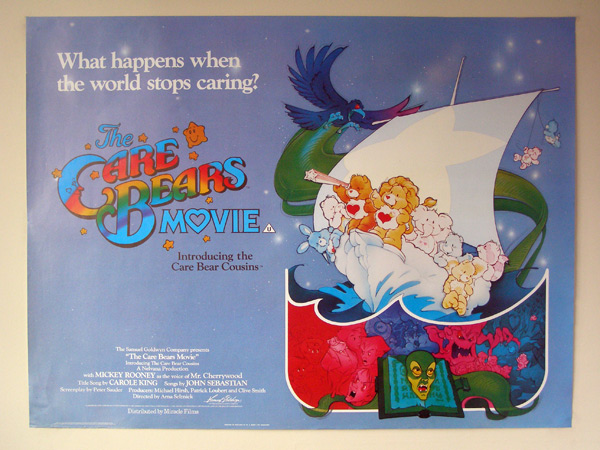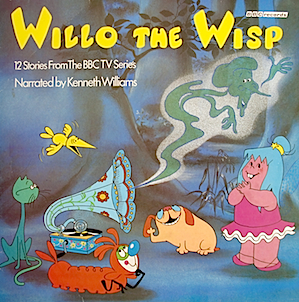 Frank Frazetta. In the movie fanzine Heroic Fantasy (Feb. 1985), artist Frank Frazetta commented on his work on the animated feature Fire and Ice (1983) that he was co-producing with Ralph Bakshi, “Fantasy works best when it emanates from some kind of logical base. Another of my priorities was to keep Fire and Ice wholesome, with the relationship between the hero and the heroine depcited romantically and the violence never overdone.
Frank Frazetta. In the movie fanzine Heroic Fantasy (Feb. 1985), artist Frank Frazetta commented on his work on the animated feature Fire and Ice (1983) that he was co-producing with Ralph Bakshi, “Fantasy works best when it emanates from some kind of logical base. Another of my priorities was to keep Fire and Ice wholesome, with the relationship between the hero and the heroine depcited romantically and the violence never overdone.
“I was also able to make general suggestions, like convincing Ralph to use a classical film score. Additionally, I stressed that the story be kept simple to better emphasize the film’s action and drama. Ralph usually loves to use hordes of characters. Less is always more in art, provided that the less is brilliant.
“I’d go from office to office correcting their (Bakshi’s artists) work and teaching them how to draw. I also brought in some of my paintings to give them an idea of what we were shooting for. Most of them picked up on my concepts pretty quickly – the background artists were especially sensational – but no one could draw the film’s wolves or giant lizard. I had to sketch every frame of those creatures myself. The colorists took it from there.”
The film’s crew included background artists James Gurney and Thomas Kinkade. Layout artist was Peter Chung who also animated on the dragon hawks. Bakshi later said that his artists were intimidated by Frazetta and his involvement. Frazetta even helped direct the live action that was later used for rotoscoping. On December 18th, 2014, Sony Pictures Entertainment acquired the rights to make a live action remake of the film to be directed by Robert Rodriguez. Bakshi says he will not be involved in any way with that production.
Daphne and Kimberley. From the Don Bluth Animation Press Release in 1983 about the videogame Space Ace, Don discussed Princess Daphne from the previous game Dragon’s Lair: “Daphne’s elevator didn’t go all the way to the top floor. But she served a purpose. She was the prize at the end of the first in a series of very difficult games for a then unsophisticated audience. And besides, Dirk her knight in shining armor, was no mental giant. Now with Space Ace, the hero Ace is more intelligent than Dirk was. And the players know more. They have loftier goals and deserve a better prize in Kimberley. They also have to be able to handle the better prize.”
Bergman and Blanc. In 1981, when voice artist Jeff Bergman was a junior at the University of Pittsburgh, he attened a lecture by Mel Blanc and followed his hero back to hotel where Blanc was staying. “I knocked on his door and he let me in. I did some things for him and he got a kick out of it. He was very gracious and spent three-quarters of an hour with me. That was an inspiration for me. After that, I began my crusade of doing these characters,” said Bergman in the L.A. Daily News January 31, 1992.
“When Blanc died, there was no one. For protection, (Warners) can’t depend on just one person. I guess that isn’t the most sensible thing. Invariably, Warners has other people they bring in. I’ve done most of the projects but I know they’re trying to groom other people.”
The Birth of Doug. In Entertainment Weekly October 14th, 2016, Jim Jinkins, creator of the animated series Doug recalled, “I was working on this math (game)show for ‘tweens but everyone who knew me knew that on the side I was drawing doodles of this character, Doug, who was my alter ego. I had worked on a book proposal and a friend at Nick called me to say they were looking for creator-driven originals to animate into series. Doug was the story of being a real kid. He’s not cool. He’s not a Charlie Brown loser. He’s in the middle. The show is like the character. At a glance, you’ll be like ‘So what?’ but if you give Doug time, he’ll grow on you.”

The Care Bears Movie. When The Care Bears Movie animated feature was released in 1985, co-producer Michael Hirsh told writer Christopher Hume of the Toronto Star newspaper: “The way to make an animated movie is to have pre-sold characters. The Care Bears are to this generation what Pinocchio was to ours. Feature length animated movies are a dying breed because of high production costs, fewer kids, movies like Star Wars and Saturday morning television.
“The Care Bears Movie will re-launch animation in a big way. Watership Down (1979) made three million dollars in rentals. We expect to make three times that. Kids’ fantasies today are different. Nowadays they want change from year to year. You have to work with that or you’re last year’s story.”
By 1989, The Care Bears Movie made over thirty-four million dollars worldwide, making it the highest-grossing animated feature film to come from Canada at that time. It should also be noted that the film was also the first modern English-language animated feature directed by a woman (Arna Selznick).
 Willo the Wisp. Willo the Wisp was an animated series (in five minute episodes) produced in 1981 for the BBC to be shown before the evening news during the week. Actor Kenneth Williams provided all the voices and the ghost-like Willo was basically a caricature of his appearance. In later years, Williams claimed he didn’t care for the series because it was “too slow” and did not fully engage the imaginations of young people and yet the show was a big hit with children and adults.
Willo the Wisp. Willo the Wisp was an animated series (in five minute episodes) produced in 1981 for the BBC to be shown before the evening news during the week. Actor Kenneth Williams provided all the voices and the ghost-like Willo was basically a caricature of his appearance. In later years, Williams claimed he didn’t care for the series because it was “too slow” and did not fully engage the imaginations of young people and yet the show was a big hit with children and adults.
The character originally appeared in a 1975 education film (Super Natural Gas) telling people what a useful thing North Sea Gas was. That was why this “Sprite of the marshes” was so “wispy” since he was originally a bluish-gas figure. For the series, the character was relocated to a magical forest called Doyley Wood based on the woods in the back of creator Nick Spargo’s home.
The characters included Arthur the opinionated caterpillar endlessly waiting to become a moth, Mavis Cruet who was a plump (too heavy to fly) heart-of-gold fairy and the villain was Evil Edna who was a witch shaped as a walking, talking television set as well as other eccentric personalities.
The series was written and directed by Nick Spargo and produced by Nicholas Cartoon Films in association with the BBC and Tellytales Enterprises. Spargo wrote all the storylines for the original 26 episodes and worked with a crew of five people for two years to produce the shows.
The series gave rise to a series of books and a comic strip. There was a revival of the series in 2004 for Disney Playhouse by Bobbie Spargo, Nicholas’ daughter. Animation on the new five-minute 26 episode series was done by Elephant Productions, Animoon Ltd and Toonz Animation India.


 Jim Korkis is an internationally respected animation historian who in recent years has devoted his attention to the many worlds of Disney. He was a columnist for a variety of animation magazines. With his former writing partner, John Cawley, he authored several animation related books including The Encyclopedia of Cartoon Superstars, How to Create Animation, Cartoon Confidential and Get Animated’s Animation Art Buyer’s Guide. He taught animation classes at the Disney Institute in Florida as well as instructing classes on acting and animation history for Disney Feature Animation: Florida.
Jim Korkis is an internationally respected animation historian who in recent years has devoted his attention to the many worlds of Disney. He was a columnist for a variety of animation magazines. With his former writing partner, John Cawley, he authored several animation related books including The Encyclopedia of Cartoon Superstars, How to Create Animation, Cartoon Confidential and Get Animated’s Animation Art Buyer’s Guide. He taught animation classes at the Disney Institute in Florida as well as instructing classes on acting and animation history for Disney Feature Animation: Florida.




















































I recall that Doug “defected” to Disney after his run on Nick where Jim Jenkins the creator of Doug created two new preschool series for Disney’s Playhouse Disney now known as Disney Junior PB&J Otter and Jo Jo’s Circus which was Jim Jenkins’ first Claymation style series that he ever created.